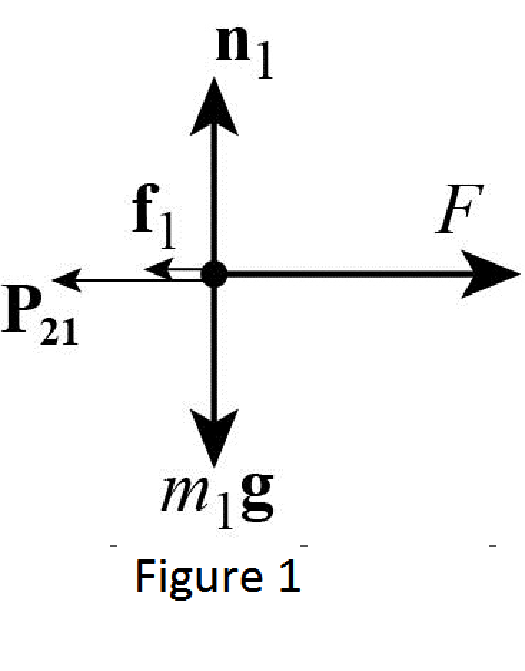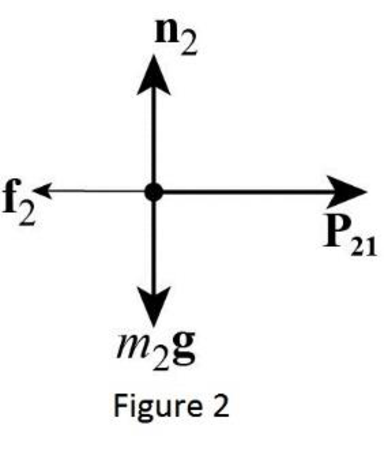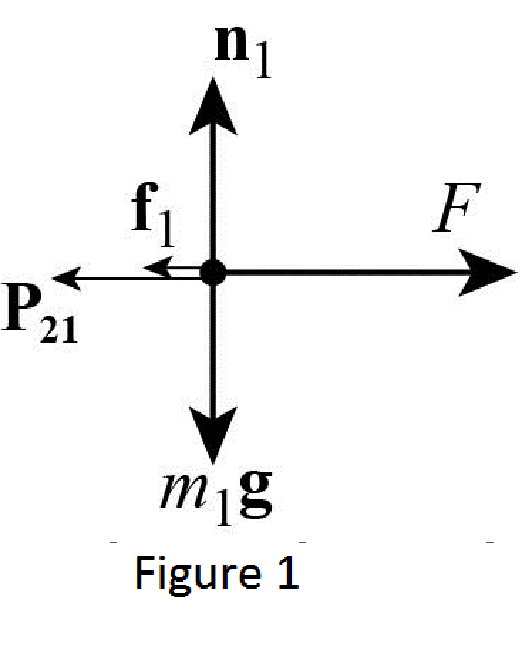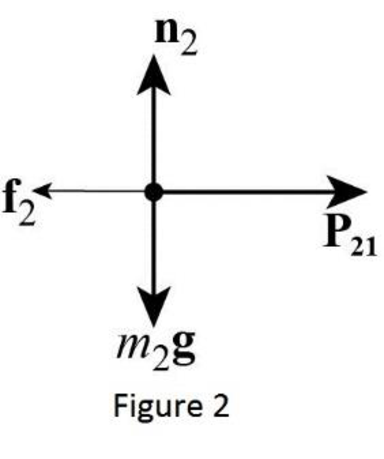
Concept explainers
(a)
Draw free body diagram of each block.
(a)
Answer to Problem 53P
The free body diagram of mass

The free body diagram of mass

Explanation of Solution
The free body diagram is the graphical illustration used to visualize the movements and forces applied on a body.
Let
The free body diagram of mass

The free body diagram of mass

Conclusion:
Therefore, the free body diagram of mass
(b)
The net force on the system of two blocks.
(b)
Answer to Problem 53P
The net force on the system of two blocks is
Explanation of Solution
From the Figure 1, write the expression for net force action on the mass
Here,
From the Figure 2, write the expression for net force action on the mass
Here,
So the net force on the system is the sum of net force on the each block.
Since contact force acting on each mass is equal.
The net force on the system of block is equal to the magnitude of force
Conclusion:
Therefore, the net force on the system of two blocks is
(c)
The net force on the mass
(c)
Answer to Problem 53P
The net force on the mass
Explanation of Solution
From the Figure 1, write the expression for net force action on the mass
The net force on the mass
Conclusion:
Therefore, the net force on the mass
(d)
The net force acting on the
(d)
Answer to Problem 53P
The net force acting on the
Explanation of Solution
From the Figure 2, write the expression for net force action on the mass
The net force acting on the
Conclusion:
Therefore, the net force acting on the
(e)
Newton’s second law in the
(e)
Answer to Problem 53P
Newton’s second law in the
Explanation of Solution
The blocks are pushed to the right, the acceleration on each block is same and the block exerts equal and opposite forces on each other, so these forces have the same magnitude.
Write the expression for Newton’s second law in the
Here,
Write the expression for frictional force.
Here,
Use equation (III) and (IV) in (I).
Use equation (III) and (IV) in (II).
Conclusion:
Therefore, Newton’s second law in the
(f)
Acceleration of the blocks.
(f)
Answer to Problem 53P
Acceleration of the blocks is
Explanation of Solution
Add equation (V), and (VI), and solve for
Conclusion:
Therefore, the acceleration of the blocks is
(g)
The magnitude of contact force
(g)
Answer to Problem 53P
The magnitude of contact force
Explanation of Solution
Solve equation (IV) for
Use equation (VII) in (VIII).
Simplify the equation (IX).
Conclusion:
Therefore, the magnitude of contact force
Want to see more full solutions like this?
Chapter 5 Solutions
Principles of Physics: A Calculus-Based Text, Hybrid (with Enhanced WebAssign Printed Access Card)
- • Nature of Resistance Temperature-Resistance Relationship Ohm's Law, Energy and Power Kirchhoff's Law • Maxwell's Mesh Analysis 1. A coil of copper wire (p = 10.37 2-cmil/ft) has a length of 600 ft. What is the length of an aluminum conductor (p 17 cmil/ft), if its cross-sectional area and resistance are the same as those of the copper coil? (Hint: Look for conversion of inches to mils and square inches to square foot. Include it in your solution.) (1 pt) 2. The copper field winding of an electric machine has a resistance of 46 at temperature of 22°C. What will be its resistance at 75°C? (Use do = 0.00427 /°C for copper) (1 pt) 3. The resistivity of a copper rod 50 ft long and 0.25 inch in diameter is 1.76 μ at 20°C. What is its resistance at - 20°C? (1 pt) 4. When two resistors A and B are connected in series, the total resistance is 36 2. When connected in parallel, the total resistance is 8 Q. What is the ratio of the resistance RA to resistance RB? Assume RA < RB. (1 pt) 5. The…arrow_forward2. Two equally strong individuals, wearing exactly the same shoes decide to do a tug of war. The only difference is individual A is 2.5 meters tall and individual B is 1.5 meter tall. Who is more likely to win the tug of war?arrow_forward6. A car drives at steady speed around a perfectly circular track. (a) The car's acceleration is zero. (b) The net force on the car is zero. (c) Both the acceleration and net force on the car point outward. (d) Both the acceleration and net force on the car point inward. (e) If there is no friction, the acceleration is outward.arrow_forward
- 9. A spring has a force constant of 100 N/m and an unstretched length of 0.07 m. One end is attached to a post that is free to rotate in the center of a smooth. table, as shown in the top view in the figure below. The other end is attached to a 1kg disc moving in uniform circular motion on the table, which stretches the spring by 0.03 m. Friction is negligible. What is the centripetal force on the disc? Top View (a) 0.3 N (b) 3.0 N (c) 10 N (d) 300 N (e) 1000 Narrow_forward4. A child has a ball on the end of a cord, and whirls the ball in a vertical circle. Assuming the speed of the ball is constant (an approximation), when would the tension in the cord be greatest? (a) At the top of the circle. (b) At the bottom of the circle. (c) A little after the bottom of the circle when the ball is climbing. (d) A little before the bottom of the circle when the ball is descending quickly. (e) Nowhere; the cord is pulled the same amount at all points.arrow_forward3. In a rotating vertical cylinder (Rotor-ride) a rider finds herself pressed with her back to the rotating wall. Which is the correct free-body diagram for her? (a) (b) (c) (d) (e)arrow_forward
- 8. A roller coaster rounds the bottom of a circular loop at a nearly constant speed. At this point the net force on the coaster cart is (a) zero. (b) directed upward. (c) directed downward. (d) Cannot tell without knowing the exact speed.arrow_forward5. While driving fast around a sharp right turn, you find yourself pressing against the left car door. What is happening? (a) Centrifugal force is pushing you into the door. (b) The door is exerting a rightward force on you. (c) Both of the above. (d) Neither of the above.arrow_forward7. You are flung sideways when your car travels around a sharp curve because (a) you tend to continue moving in a straight line. (b) there is a centrifugal force acting on you. (c) the car exerts an outward force on you. (d) of gravity.arrow_forward
- 1. A 50-N crate sits on a horizontal floor where the coefficient of static friction between the crate and the floor is 0.50. A 20-N force is applied to the crate acting to the right. What is the resulting static friction force acting on the crate? (a) 20 N to the right. (b) 20 N to the left. (c) 25 N to the right. (d) 25 N to the left. (e) None of the above; the crate starts to move.arrow_forward3. The problem that shall not be named. m A (a) A block of mass m = 1 kg, sits on an incline that has an angle 0. Find the coefficient of static friction by analyzing the system at imminent motion. (hint: static friction will equal the maximum value) (b) A block of mass m = 1kg made of a different material, slides down an incline that has an angle 0 = 45 degrees. If the coefficient of kinetic friction increases is μ = 0.5 what is the acceleration of the block? karrow_forward2. Which of the following point towards the center of the circle in uniform circular motion? (a) Acceleration. (b) Velocity, acceleration, net force. (c) Velocity, acceleration. (d) Velocity, net force. (e) Acceleration, net force.arrow_forward
 Principles of Physics: A Calculus-Based TextPhysicsISBN:9781133104261Author:Raymond A. Serway, John W. JewettPublisher:Cengage Learning
Principles of Physics: A Calculus-Based TextPhysicsISBN:9781133104261Author:Raymond A. Serway, John W. JewettPublisher:Cengage Learning Physics for Scientists and Engineers: Foundations...PhysicsISBN:9781133939146Author:Katz, Debora M.Publisher:Cengage Learning
Physics for Scientists and Engineers: Foundations...PhysicsISBN:9781133939146Author:Katz, Debora M.Publisher:Cengage Learning Classical Dynamics of Particles and SystemsPhysicsISBN:9780534408961Author:Stephen T. Thornton, Jerry B. MarionPublisher:Cengage Learning
Classical Dynamics of Particles and SystemsPhysicsISBN:9780534408961Author:Stephen T. Thornton, Jerry B. MarionPublisher:Cengage Learning University Physics Volume 1PhysicsISBN:9781938168277Author:William Moebs, Samuel J. Ling, Jeff SannyPublisher:OpenStax - Rice University
University Physics Volume 1PhysicsISBN:9781938168277Author:William Moebs, Samuel J. Ling, Jeff SannyPublisher:OpenStax - Rice University Physics for Scientists and Engineers with Modern ...PhysicsISBN:9781337553292Author:Raymond A. Serway, John W. JewettPublisher:Cengage Learning
Physics for Scientists and Engineers with Modern ...PhysicsISBN:9781337553292Author:Raymond A. Serway, John W. JewettPublisher:Cengage Learning Physics for Scientists and EngineersPhysicsISBN:9781337553278Author:Raymond A. Serway, John W. JewettPublisher:Cengage Learning
Physics for Scientists and EngineersPhysicsISBN:9781337553278Author:Raymond A. Serway, John W. JewettPublisher:Cengage Learning





